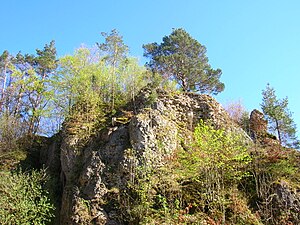Hauseck castle ruins
| Hauseck castle ruins | ||
|---|---|---|
|
View of the Oberburg from the Hauseck ruins from the northwest |
||
| Creation time : | Probably between 1329 and 1338 | |
| Castle type : | Höhenburg, summit location | |
| Conservation status: | Upper castle: ruin at risk of disposal, lower castle: converted into a private agricultural property | |
| Standing position : | Count Palatine | |
| Construction: | Quarry stone masonry | |
| Place: | Etzelwang house corner | |
| Geographical location | 49 ° 33 '12.4 " N , 11 ° 33' 28.1" E | |
| Height: | 540 m above sea level NN | |
|
|
||
The Hauseck castle ruins are a former late medieval aristocratic castle above the town of Hauseck east of Hirschbach in the Upper Palatinate district of Amberg-Sulzbach in Bavaria . The upper castle of the ruin is freely accessible, a large part of the lower castle is privately owned and cannot be entered.
Geographical location
The ruins of the Gipfelburg are located in the Franconian Switzerland-Veldenstein Forest Nature Park immediately northeast of the village of Hauseck on the Hausecker Schlossberg in the Etzelwang municipality , about 1.4 kilometers east-southeast of the church in Hirschbach . It is divided into an upper castle on a rocky reef at a height of 505 meters and a lower castle that stood at the western foot of the reef.
The best way to get to the former castle is from Hauseck by following the road that leads through Hauseck to its end. This is where the private estate begins in the lower castle. To get to the rock reef of the upper castle, follow a footpath steeply up on the western side of the reef.
To the southeast in the vicinity are the Rupprechtstein castle ruins with the Werdenstein castle stables and another castle stables , known as the " Trutziger Kaiser ". To the north-east near Eschenfelden is the Altenburg castle stable on the Wachtberg and to the north the Hartenstein castle ruins .
History of the castle
Hauseck Castle was first attested to in 1338 in a contract for the division of the Palatinate County between the sons of Duke Rudolph I and her nephew Ruprecht II . In the house contract of Pavia of August 4, 1329, with which the territorial duchy of Bavaria was divided, Hauseck was not yet mentioned, which speaks for a relatively late construction between the years 1329 and 1338. The castle was probably built by Duke Rudolph I to secure his claims to power against the Reicheneck taverns. A well-founded archaeological investigation into the origins of the castle is still pending (as of 2009).
The Count Palatine could not hold their Hauseck Castle for long. They had to pledge the complex and large parts of the Upper Palatinate because of financial obligations to the then Roman-German and Bohemian King Charles IV in 1353.
In 1354 King Charles IV gave the castle as a Bohemian fiefdom to the Queen's Chamberlain , Konrad von Kemnath, and also granted him the right to open it . A little later his presumed sons Johann, Conrad and Heinrich Kemnather inherited the fief and renewed the opening rights in 1358. Heinrich XI. von Wildenstein and his wife Elsbeth von Henfenfeld acquired the fief shortly afterwards and passed it on to their relative Ulrich von Henfenfeld on February 6, 1372. He sold Hauseck on May 26, 1380 to Stephan von Wolfstein.
Hauseck Castle remained a Bohemian fiefdom, but according to the Treaty of Fürstenwalde , in which the previous Elector of the Mark Brandenburg , Otto V , was granted the right to rule over the Mark Brandenburg in return for a compensation of 500,000 guilders and some castles and towns in the Upper Palatinate In favor of the Luxembourgers, the opening rights fell to the Bavarian dukes from 1373.
Before 1489, the Laufer Hammerherr Jörg Petz acquired the castle from the Wildensteiners, but sold it in 1492 to Sebold Peringsdorfer and his son-in-law Jobst II. Haller . He left the use of the castle to the Nuremberg Council around 1500.
In the Landshut War of Succession , which concerned the succession of the Bavarian dukes, Hauseck Castle was captured by the Palatinate in 1504, but was reclaimed by Nuremberg troops.
In 1507 the castle was then by Jobst III. Haller sold to the imperial city of Nuremberg and probably repaired by the Nuremberg master stonemason, Michael Beheim. It became a Nuremberg nursing home.
The end of Hauseck Castle came in the Second Federal War , in which Albrecht Alcibiades , Margrave of Brandenburg-Kulmbach and Bayreuth , undertook numerous raids and looting that led to the destruction of many places and castles in the empire, especially in Franconia. His troops marched in front of the castle on May 27, 1552 and set it on fire. She then left the imperial city in ruins. In 1774 there is only talk of a ruined pile of stones.
Today, in the area of the lower castle, of which almost nothing has survived, there is a private property, the upper castle on a rocky reef is threatened with complete decline.
literature
- Robert Giersch, Andreas Schlunk, Berthold Frhr. von Haller: Castles and mansions in the Nuremberg countryside . Published by the Altnürnberger Landschaft eV, Lauf an der Pegnitz 2006, ISBN 978-3-00-020677-1 , pp. 178–180.
- Stefan Helml: Castles and palaces in the Amberg-Sulzbach district . Druckhaus Oberpfalz, Amberg 1991, pp. 94-95.
- Karl Wächter, Günter Moser: In the footsteps of knights and nobles in the district of Amberg-Sulzbach . Book and Kunstverlag Oberpfalz, p. 25.
- Ursula Pfistermeister: Castles of the Upper Palatinate . Verlag Friedrich Pustet, Regensburg 1974, ISBN 3-7917-0394-3 , p. 87.
Web links
- Hauseck castle ruins on the castles and manor side in the Nuremberg countryside



